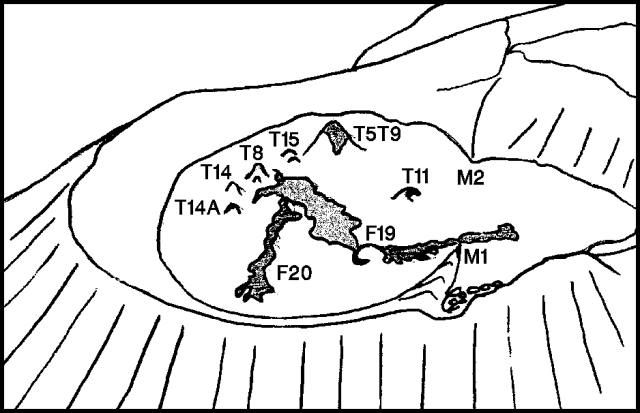Report on Ol Doinyo Lengai (Tanzania) — November 1990
Bulletin of the Global Volcanism Network, vol. 15, no. 11 (November 1990)
Managing Editor: Lindsay McClelland.
Ol Doinyo Lengai (Tanzania) Continued lava production from several summit crater vents
Please cite this report as:
Global Volcanism Program, 1990. Report on Ol Doinyo Lengai (Tanzania) (McClelland, L., ed.). Bulletin of the Global Volcanism Network, 15:11. Smithsonian Institution. https://doi.org/10.5479/si.GVP.BGVN199011-222120
Ol Doinyo Lengai
Tanzania
2.764°S, 35.914°E; summit elev. 2962 m
All times are local (unless otherwise noted)
Oblique air photos taken by Steve Cunningham . . . on 7 September (figure 19), showed minor changes in crater activity since a 7-8 August crater visit. There was no sign of very fresh lava on T4/T7, . . . although the W end of the ridge was surrounded by fresh lava. A large dark-gray patch of lava extended from the top to near the base of the largest cone in the crater, T5/T9, suggesting recent spatter or minor overflow of lava from its summit vent. T15 . . . continued to erupt, as indicated by the presence of dark gray lava and a possible small fresh flow just N of it. Most of the crater floor was covered by older pale gray to white lava, including a large flow active 7-8 August (F18). Two new flows (F19 and F20 in figure 19) were visible, the longer extending 200 m across the crater floor and into the S depression. It was estimated that this flow was 1-2 days old at the time of the photograph.
 |
Figure 19. Active crater at Ol Doinyo Lengai, 7 September 1990, looking NE. Shaded areas show fresh lava flows. Tracing of photo courtesy of C. Nyamweru. |
Geological Summary. The symmetrical Ol Doinyo Lengai is the only volcano known to have erupted carbonatite tephras and lavas in historical time. The prominent stratovolcano, known to the Maasai as "The Mountain of God," rises abruptly above the broad plain south of Lake Natron in the Gregory Rift Valley. The cone-building stage ended about 15,000 years ago and was followed by periodic ejection of natrocarbonatitic and nephelinite tephra during the Holocene. Historical eruptions have consisted of smaller tephra ejections and emission of numerous natrocarbonatitic lava flows on the floor of the summit crater and occasionally down the upper flanks. The depth and morphology of the northern crater have changed dramatically during the course of historical eruptions, ranging from steep crater walls about 200 m deep in the mid-20th century to shallow platforms mostly filling the crater. Long-term lava effusion in the summit crater beginning in 1983 had by the turn of the century mostly filled the northern crater; by late 1998 lava had begun overflowing the crater rim.
Information Contacts: C. Nyamweru, Kenyatta Univ.

